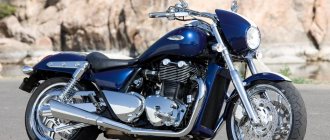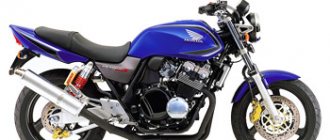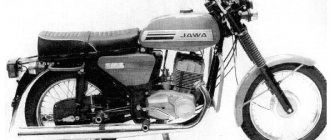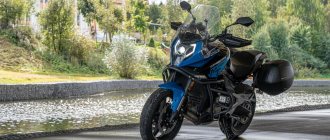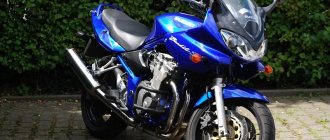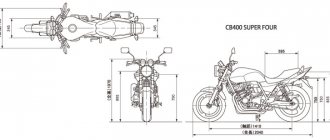The F800 GS motorcycle was first presented at the EICMA exhibition in Milan in November 2007. Sales of this model from BMW began in early 2008. The BMW F800 GS is a version of the F650GS, which was produced from 2008 to 2012, but differs from it in its greater off-road focus and more expensive equipment. The BMW F800 GS copes excellently with deep fords, sand dunes, and even mountain passes. For him, moving on any type of road is not a problem. This BMW model is the ideal vehicle for long journeys. It is equipped with a powerful frame and features large suspension travel. Already in the standard version, the F800 GS is equipped with ABS and has 2 driving modes. Optionally, you can select 1 of 4 driving modes. Comfort of movement on any surface is guaranteed by the directional stability system. By the way, when riding off-road, ABS on the F800 GS motorcycle can be turned off. A large number of original accessories and special equipment from BMW motorcycles allows you to adapt the F800 GS to your own requirements and preferences. All of them have characteristics such as functionality, practicality and impeccable appearance. With accessories you can always emphasize the expressiveness of BMW style. The main unit of the motorcycle is a fuel-injected in-line 2-cylinder Rotax engine. It has a power of 85 horsepower, a torque of 83 Nm and a displacement of 798 cc. cm. The performance of such a BMW motorcycle engine is 5.5-7.5 thousand revolutions per minute. Features of the F800 GS include: • steel frame; • adjustable suspension; • monoshock absorber; • single-disc rear and double-disc front brakes; • spoked wheels with a diameter of 17 and 21 cm; • 16 liter fuel tank. Immediately after its release, this model was highly appreciated by experts. In 2009, the F800 GS received the title of “Motorcycle of the Year”. It has often been compared to the legendary Honda Africa Twin. This model was also compared with the R1200GS. Experts appreciated the greater accessibility and lighter weight of the vehicle. Fans of the brand and positive reviews from experts did their job. For more than 10 years, approximately 10,000 products have been sold per year. This model from BMW is available in two color schemes: • Rallye – the white-black-red version emphasizes not only its confident character, but also the incomparable abilities demonstrated when moving off-road; • Racing Blue metallic – in this color scheme, combining metallic, blue and black, the BMW model looks as stylish and dynamic as possible, allowing it to highlight the individuality of its owner.
Main modifications
F800 GS is available in the following versions: • standard F800 GS; • luxury F800 GS Adventure. The luxury version of the model from BMW has been available since 2013. It differs from the standard one: • in the shape of the windshield; • fuel tank with increased volume (24 liters versus 16); • engine protection; • a seat with a modified shape; • hand protection; • built-in fastenings for cases; • traction control system; • electronically adjustable suspensions. Throughout its history, this model from BMW was modernized only in 2013. The update was cosmetic. The F800 GS model received a new form of plastic, a different radiator grille and several other innovations. All of them were immediately noted by both potential buyers and experts.
Technical characteristics of the BMW model
Type: touring enduro. Frame: tubular steel. Engine: injection 4-stroke 2-cylinder with a displacement of 798 cc. cm, power 85 l. With. with a torque of 83 Nm. Cooling: liquid. Valves: 4 per cylinder. Ignition: digital. Transmission: 6-speed. Drive: chain. Tires: 90/90-21 54V (front), 150/70-17 69V (rear). Brakes: 2 discs, 300 mm, 2-piston calipers with ABS (front), 1 disc, 265 mm, 1-piston caliper with ABS (rear). Suspension: 43 mm inverted fork, travel - 230 mm (front), pendulum with monoshock absorber (adjustable preload and rebound), travel - 215 mm (rear). Gas tank: 16 liters (standard version) and 24 liters (Adventure). Maximum speed: 204 km/h. Curb weight of the BMW motorcycle: 214 kg. Acceleration to 100 km/h: 4 seconds.
Test drive: BMW F 800 GS Adventure (2015) – A true enduro
There is an opinion that BMW makes “just good” road motorcycles, but you can’t generalize under the word “road” all motorcycles with a propeller on a gas tank! Since 2008, I had the opportunity to ride on different GSs and write a dozen tests, most of which, of course, had nothing to do with real tests. Well, what can you say about the BTR-90 when riding it in the city? Gluttonous, clumsy, slow, no visibility, the gun clings to everything that hangs low - in general... The invitation to the Andreapol rally-raid in the Tver region, where in 2013 I tested the KTM 1190 Adventure, came at just the right time: fast roads , slow roads, “road type”, their complete absence and kilometers of sand grader on the shores of picturesque lakes - this is where there is a chance to experience the “dark side” of BMW.
MOTOGONKI.RU, June 5, 2015 —
Gelände und Straße
“GS” literally means “Off-road / Road” in equal amounts, that is, 50/50. This is the main definition around which everything in this motorcycle revolves.
BMW F 800 GS Adventure (2015)
The BMW F 800 GS debuted in 2008, and then the MOTOGONKI.RU portal sent its specially trained test pilot Thor Sagen to test the new product in South Africa; his impressions of the motorcycle were “moderately enthusiastic,” which is understandable: after all, our fast Norwegian is not tried Adventure, which was born in all its glory in 2013!.. He would definitely like it.
BMW F 800 GS Adventure (2015)
The 50% “strasse” that a motorcycle contains in its name can be seen as a kind of necessary evil on the path to true discoveries that lie beyond the borders of the concrete jungle.
On the pavement, the bike requires you to rev the engine: a 798 cc inline twin with 85 hp. pulls the motorcycle forward evenly, but the gears of the endurable gearbox, designed to pull the bike out of any mud, are quite “short”, so even in slow traffic you quickly switch to 5th. The normal operating range is 3000-5000 rpm, and above 6000 unpleasant vibrations appear on the footrests, which can be considered as an indicator of leaving the “comfort zone”. The way the bike behaves in the "comfort" range has an interesting effect: it insists on constantly moving forward, aggressively going through the gauntlet, imposing its own pace.
And I noted this feature of the F800GS: after driving through Moscow traffic jams for half a day (Friday, sir), for a couple of hours I didn’t put my feet on the asphalt - I didn’t stop, even when the traffic got up tightly, and a traffic jam formed in the “motor lane” of the Moscow Ring Road (this time from motorcyclists).
Control panel of the BMW F 800 GS Adventure: turn on the Enduro mode and - hit the road, get off the asphalt!
The chassis of the BMW F800GS Adventure is a neatly balanced system with a 21-inch front and 17-inch rear wheel, shod with standard Pirelli Scorpion TRAIL tires (more on that a little later). Engine as a load-bearing part of the chassis; but, unlike other implementations of such a scheme, the frame not only performs the function of connecting the power unit with the front-end (upside-down fork with feathers with a diameter of 43 mm), but also additionally supports the rear-end, providing double rigidity in the connection between the motor and the pendulum rear wheel and shock absorber. This makes the motorcycle extremely stable on the arc.
At the same time, the response to steering movement is not as sharp as that of a road bike. The main control tool for the F 800 GS is countersteering. While on a low-slung road bike with wide 17-inch wheels, the movement itself to change direction starts from the wheels, in the case of the F800GS, the tilt starts from the top and “waves” up to the axles. To make this happen faster, you need a little more effort. In fact, the Adventure easily passes the same “snake” and fits into a 3-meter ring on the driving range after a little training.
The huge profile of the stock Pirelli tires allows the bike to lean into corners, which is required if you want to fit into fast corners. Thanks to the spoked rims and suspension, the chassis receives much less vibration from unevenness on the asphalt, so the “tolerance” of the motorcycle (and the pilot) to the quality of the surface is an order of magnitude higher than that of ordinary road bikes. And in general, it doesn’t matter what the quality of the surface is or whether it exists at all: where “street” and “sportbikes” slow down in order to lower the front leg into the hole first, and then the rear one, the BMW flies forward at the same speed that it went before this. Speed bumps? “Slight unevenness of the asphalt” for GS!
The protection of the levers is functional: hands remain dry in the rain, stones do not get into the fingers, the wind does not cold the former wound
In the city, the ground clearance is enough to easily drive onto curbs of any height and park “where I want.” In nature, this same feature is more helpful when you have to cross water and mud barriers or climb over fallen trees. The basic crankcase protection is strong enough to allow you to park the bike on an obstacle to catch your breath before the second push.
The BMW F 800 GS Adventure is equipped as standard with ESA with three suspension settings – Comfort, Normal and Sport. I can honestly say that as soon as I left the city where I was using “Sport” (the hardest), I switched to Comfort (the softest) and never changed the suspension setting again, how well it suited my dimensions and needs.
ESA control on the left remote control + turning on the fog lights
But the Bavarians introduced ASC (braking stability control) into a medium-sized enduro motorcycle for the first time in the F 800 GS Adventure, and this thing is truly useful. The traction control system monitors the level of grip of the rear wheel on the surface, reducing traction if a stall begins. The names of the riding modes with ASC – “Road” and “Enduro” – speak for themselves: in the enduro mode, wheel stall is not controlled, which allows you to dig and climb without restrictions. On the road, I noticed the ASC triggering a couple of times when I was shooting too aggressively past traffic jams on the dusty side of the road.
Moreover, for enduro riding, as is expected of a proper motorcycle, the pilot's footpegs are equipped with removable rubber pads, under which a ribbed base is hidden for reliable grip with the sole of off-road motorcycle boots. The brake foot also has a pad that flips to the side so that you don’t have to readjust the pedal height when driving with the pads (in road mode) or without them (in off-road mode).
Speed isn't everything
In the case of the GS Adventure, it is difficult to decide clearly what type of motorcycle it should be classified as - fast or not very fast. We are still talking about riding on asphalt, and the F800 engine will not allow the bike to accelerate to 200. But here another rule comes into play: if he can maintain an average speed of 100 km/h over a long stretch of the road, he will pass for “fast”. How is the average speed achieved and what does it consist of?
For example, the M1 highway: from Moscow to Brest, 1100 km on a highway “liter” with a developed fairing can be covered in 9 hours. There will be at least 4 refueling stops: the first in Vyazma, the second in Krasnaya Gorka, then before the Minsk district, and the last in Baranovichi. Each stop, even in pit stop mode, is 5-10 minutes. Coffee? Already 30.
On hard surfaces the F 800 GS feels even too confident
The average speed on the route will be approximately 120 km/h, which looks good for most “tourists”. In my practice, there is a record of 7.5 hours, but with 6 stops. And there is also an unfortunate example at 11 o’clock, which was due to disgusting weather conditions and extensive road repairs. In each case, the average travel speed was 100 km/h or more. If the weather and traffic allow us to go “all out”, we open the handle. Fuel consumption, at the same time, increases to 9-10 l/100 km. The faster we go, the higher the consumption - less mileage per gas station => more stops. For a motorcycle of the “1000+” class, the mileage on one tank can be from 180 to 250 km, which depends on the pace and quality of gasoline. Only if you drive according to the regulations (120 km/h), you can travel 300 km with 17-18 hp. But riding for more than two hours without a break is not an easy task for most motorcyclists.
I have not yet had the opportunity to ride on such a long tour on the BMW R1200GS Adventure and KTM 1290 Super Adventure equipped with huge 30-liter tanks, so I don’t have actual figures on the power reserve on hand. Theoretically, each of these tourists allows you to travel up to 600 km without stopping, and comfortable seats made of new materials with good support and the ergonomics of the motorcycle expand the physical capabilities of the pilot. So is it possible to sit behind the wheel for 3-4 hours in a row and not get tired?
Now I can well imagine what a gigantic advantage this opportunity gives when traveling, because now there is a living example of the BMW F800GS Adventure, equipped with “only” a 24-liter tank and a comfortable touring seat.
Staged shooting or not, I’m ready to confirm: the BMW F800GS feels comfortable on a hard boot and a loose grader!
From Moscow to the center of Andreapol there are exactly 387 km, more than 300 of which are smooth asphalt “M9”, the rest are local highways. The quality of roads in the Tver region is legendary. The only thing that can be said about them is that there is... asphalt there. And I managed to cover this distance - twice, there and back - in 3 hours, without a single stop, after which there were still about 2 liters of AI-95 left in the tank, and a sufficient charge of vigor in my back and shoulders for another 50-60 kilometers, just until the tank is completely drained.
387 km in 3 hours is 129 km/h average speed on a route where people in “loaves” and Big Black Jeeps prefer to travel a sixth of the way at a speed of “60” so as not to spill the contents of their stomachs. Adventure went there at 140, without showing the slightest sign of dissatisfaction, and the instantaneous flow sensor seemed to hover at around 5.8 liters.
Average consumption for the entire trip was 6 l/100 km, which gives me the right to calculate the total mileage on one gas station - this is a guaranteed 420 km (which has already been tested in practice) with a power reserve of up to 450 km even at the “1000 miles per day” pace. BMW claims consumption of 3.2 l/100 km at around 90 km/h. From Moscow to St. Petersburg, 750 km is the distance that the BMW F800GS Adventure can travel on one tank, although it will take a long time to travel! But once you get off the road and drive at such a pace not on the highway, you can forget about refueling for the whole day.
Winding roads, no matter what quality, will bring a lot of pleasure to the pilot of the BMW F 800 GS!
The optimal driving pace in a group is about 120 km/h, which would allow the touring team to plan a route without worrying about finding a gas station, even in the most remote areas of the world.
The F800GS's 6th gear is very flexible on the highway. You can drive 80 or speed up to 180 if the situation allows. The company claims that the F800GS top speed is 192 km/h. According to the GPS track, I never accelerated faster than 164, but I never slowed down below 94. The pace provided by the 85-horsepower engine allowed me to move almost 40 km/h faster than the traffic. Safely. Fast. Without a hint of fatigue. I will probably repeat this last point many more times, because this is an important factor on long trips.
You can trust the BMW speedometer readings: the Bavarian gives reasonable indicators with an error of less than 5%, and I would attribute those to the inertia of the dial gauge.
At the same time, the F800GS has no chance of competing in speed with “plastics” on the highway. The F800GS engine is different from those found in the F800R and F800GT. The F 800 GS has different camshafts to provide more torque, completely different gear ratios in the gearbox, and the engine itself is mounted almost vertically in the chassis. The goal is to install a large cooling radiator to provide better engine cooling off-road, when you have to climb for a long time in 1-2 gears. And, of course, where the Honda “six hundred” manages to accelerate to 180 and go to the point, the Adventure only does 160.
But can a sportbike get around a traffic jam without slowing down on a loose embankment? Stop and wait with everyone else, lowly creature!
Another important factor is visibility. The BMW F800GS Adventure is clearly visible on the road. First of all, it's big. Secondly, the LEDs used in the side headlight are truly bright, and the xenon low beam provides excellent visibility at any time of the day, and is noticeable from afar. BMW will always give way, both in the city and on the highway.
By this combination of all these parameters, the BMW F800GS Adventure is a damn fast bike! Not in terms of maximum speed, but simply in life.
Something Big Brother doesn't have
Separately, I would like to raise the topic of “weather protection”. The test Adventure was equipped with standard heated grips and a large touring windshield, as well as plastic lever protection. Each of these elements worked 100%.
These tanks are not afraid of dirt
The rainy weather that settled in Moscow on the day of departure for the rally came precisely from the Tver province, so I went to the races, clearly knowing what awaited me. Approximately 50% of the way to Andreapol passed through rain of varying degrees of severity, but visual control of the road was always clear, thanks to the elimination of water dust and the high transparency of the windshield; A minimum of liquid got onto the helmet visor. The gloves remained dry until the sky began to pour heavily and vertically. But, thanks to the high-quality heating of the handles, this trouble did not affect comfort.
A feature of the BMW F800GS Adventure that sets it apart even from its older brother, the R1200GS, is its incredible stability in gusts of wind. Even with the tightest ESA settings, the Big Goose has a sin that cannot be eliminated, especially if panniers are installed - wobbling at high speeds. So, during the entire trip on the F800GS I never observed this effect: the weight distribution did its job.
Enduro in its purest form
I don't know if it's worth seriously talking about riding a motorcycle in deep mud, wet clay and sand on road tires. Although the Pirelli Scorpion TRAIL is intended to be used equally on and off-road, the name “TRAIL” itself means an unpaved road, not pure off-road.
An unpaved road can be called well-compacted gravel or primer, where these tires really hold up well. There are plenty of such paths in Poland and Russia, but in Germany, Italy and Switzerland they can only be found high in the mountains, on passes, in front of which there are usually “no road” signs.
Deep puddles are no longer an irritant after one day of riding the F 800 GS
Returning to ASC. Even in the “Road” mode, when the traction control closely monitors the slipping of the rear wheel, the motorcycle in 1-2 gears easily overcomes dry, dusty paths, if you do not rip off the gas. The chassis provides precise handling, mainly thanks to the 21st front wheel. Even taking into account the “roadiness” of the Scorpion TRAIL, longitudinal unevenness and ruts of medium depth, as long as the wheel does not go into them up to the rim, the motorcycle is not afraid and, if desired, jumps from one to another. In Enduro mode, the rear wheel can slide without restriction. When driving through deep puddles, not knowing for sure what is at the bottom - soft and viscous or still hard, not swollen, the main thing is to keep the gas steady! GS will take you out: the rear wheel can move from side to side, but the front one clearly maintains the chosen trajectory.
A normal off-road from the point of view of the owner of a BMW F 800 GS Adventure looks something like this
What I talked about just above: a serious advantage of the F800GS, as an Enduro-type motorcycle, over the R1200GS is better weight distribution and lower curb weight (229 kg). In the case of the “1200” on road tires, if you just hesitate a little, miss the moment, cover the throttle a little more than it should, the front wheel immediately sinks into sand or fine, loose gravel. It sinks so much that the movement immediately stops and the motorcycle falls on its side. The F800GS, if it has the engine running and the rear wheel continues to spin, first of all, it won't dig up. Secondly, there is not the slightest fear that the bike is about to get out of control and try to lie down. 229kg isn't easy either, but the bike is controlled and easier to keep upright.
All the advantages in one picture: the crankcase protection is complete and functional; arches and hook-and-loop footrests, as well as a special pedal
Finally, it is not difficult to pick up a motorcycle that has fallen to the ground by applying a little force to the handlebars and, for example, the luggage mount or frame. I remember well how I lifted the R1200GS that had fallen on its side: it happened on the second approach, when I found the right point of application of forces. At BMW they teach that you need to lift the motorcycle with your back, otherwise it’s easy to injure yourself. I picked up the F800GS twice – usually, and then “on my back”, just to make sure that the first time it was not just a surge of adrenaline. What is the risk of a road bike falling? Most likely, calling a tow truck.
BMW F 800 GS Adventure: a larger 24-liter gas tank is protected by the saddlebag mounting frames that come in the base
In the case of a touring enduro, the force distribution points when sliding prevent damage to the vital organs of the motorcycle. Plus, the fuel tank of the F800 is located not at the top, but under the seat, which not only reduces the center of mass, but also provides additional safety in case of accidents: the side walls are reliably protected by the frame for attaching luggage cases.
Total
I just got off the motorcycle after almost one and a half thousand rally, picked up my Suzuki and only after a few kilometers I realized: they are fundamentally different! How could I drive so fast here just yesterday? Where did all these incomprehensible obstacles come from - sand, removed asphalt, cars, some kind of holes that simply did not exist for BMW?! Reading the press releases, it is simply impossible to understand what the BMW F800GS is like. If you're feeling the hankering for an Adventure motorcycle, be sure to take a BMW motorcycle for a test drive in Independence to get a feel for what it's all about. Get stuck in city traffic jams, take a detour along the Moscow Ring Road, but then - be sure to! – turn off the highway onto the nearest dirt road, into the forest or into an open field. Evaluate the feeling of how you cross the place where just yesterday you were fearfully shuffling your feet, trying to cross a “big scary puddle” on your road bike, with the F 800 GS, without even standing up on the pegs.
Now I know exactly what kind of motorcycle I should ride on the BMW GS Trophey! Exactly on the F 800 GS.
The Adventure package significantly expands the possibilities for tourism, radically changing the rules of long-distance driving and yesterday's accents: instead of turning off the gas on a straight line, there is a short route that you would not have thought about until now.
The motorcycle was provided for testing by the official dealer “Independence-BMW”. Sign up for a test drive via the website or by phone: +7 495 787-8008
Photo: author and official press photos

